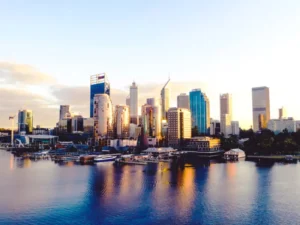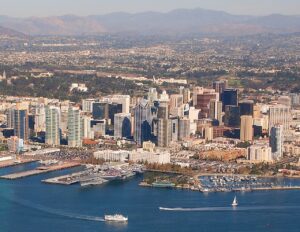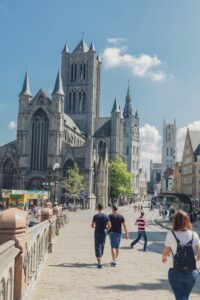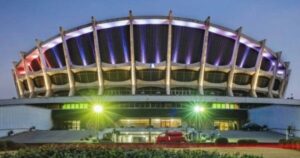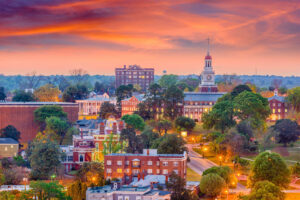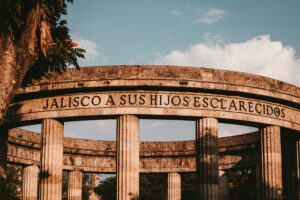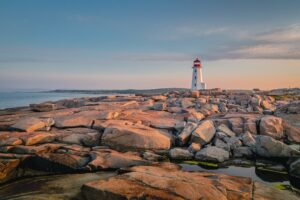In recent decades, Oeiras has seen some very significant changes. Namely, the housing qualification cycle – Oeiras was the first municipality in the country to eliminate shanties, providing decent housing to all residents. The cycle of attracting business, science and innovation is also worth mentioning; Oeiras is home to the largest Portuguese business park and the largest set of business parks in the country, as well as having 30% assets in the field of science and innovation.

Oeiras, located in the heart of the Lisbon Metropolitan Area (LMA), has had a journey that has transformed the municipality into an undeniable reference for territorial development in Portugal. Today it is a leader in the fields of science, technology and innovation. We intend to go further, continuing to develop the quality of life of our residents and everyone who works here; as well as providing unique experiences to those who visit us; contributing to the consolidation of the Metropolitan Area of Lisbon and to the projection of Portugal in the world.
In 2027, Portugal will host one of the most popular European Union initiatives: the European Capital of Culture programme. This programme has promoted opportunities for cultural and territorial development, urban rehabilitation, and national and international projection, as well as attracting tourism. Lisbon (1994), Porto (2001) and Guimarães (2012) have already received this award, and each of these municipalities has interpreted, in their own way, what it means to be the European Capital of Culture.
The municipality of Oeiras has decided to apply for the title of European Capital of Culture 2027.
The decision to make this application catalyses a new cycle, and we want to achieve the objectives, regardless of whether we are awarded the title, or not. Oeiras 27 includes Oeiras’ application to become the European Capital of Culture 2027, but it is a programme that is projected onto a broader horizon.
The new cycle that we are now promoting makes Oeiras 27 a decisive moment in our growth timeline. We want to call on all the employees of the municipality and, of course, the civil parish councils, as well as a close collaboration with the townspeople in general, with cultural agents and entrepreneurs, with schools, universities and research centres, with sports and social development organisations.
Naturally, the coordination with our neighbouring municipalities and with the Metropolitan Area in general will be essential.
For many years now we have been pushing a vision of a polynucleated city project for Oeiras, promoting the connection and mobility between the various urban, business, cultural, scientific, technological, educational, social and sports centres, offering the community of Oeiras and those who visit us an integrated vision of the territory.
For decades we have shown that we have had inclusion and social cohesion policies, and now we are trying to take community dynamics, participation and quality of life to a new level. This will be done in a sustainable and inclusive way, with the contribution of digital interfaces and all associated technologies, but based on citizenship, in a project for a democratic, balanced city, which values people and our balance with Nature.
We now want to transform the 46 km2 of the Municipality of Oeiras into the City of Oeiras, a city in the heart of the Metropolitan Area. The application to become the European Capital of Culture will be a driving force, in a coherent combination with the Oeiras Science and Technology strategy and the Oeiras Valley brand.
We are working towards the creation of a coordinated urban fabric (criação de um tecido urbano articulado), with meeting spaces for citizens, parks and green areas, pedestrian and cycling circuits, with a 12-kilometre riverfront prepared to be enjoyed in its enormous diversity, with cultural and sports facilities, business parks and educational and tourist facilities, food and leisure areas.
This is a step that reflects a plural, creative, qualified, cosmopolitan, competitive city. An innovative city, pioneer in the fields of science, technology, arts and culture, in civic and business participation and in the promotion of advanced urban ecosystems.
A city with its own centrality, but one that is coherent with Lisbon and within the framework of the Metropolitan Area.
A city that promotes its international connections, with the Portuguese-speaking countries in Africa, with sister cities in different parts of the world, as well as with world-class artistic and cultural, scientific and technological hubs from all over the world.
We already offer high standards to the people of Oeiras, but we know that we can do more in the current context. This should not limit us, but rather it requires a greater effort from us. I know we are up to this new challenge. Because we can shape our future.
Isaltino Morais
Mayor of Oeiras
CULTURE IN OEIRAS’ NEW CYCLE
It is well known that the word culture comes from Latin, and that initially it referred to matters of the land – culture and agriculture have the same roots. The word, like so many others, has had different meanings over the centuries, accompanying and influencing the stories of men and the world.
What is culture in these uncertain and complex times we are living in?
Culture is a capacity: capacity to interpret and criticise, to identify and participate. Culture is present in everything that is human or relates to humans – from politics to gastronomy, from literature to industry, from arts to journalism, from economics to history, from heritage to religion. Culture is the eyes with which we read the world and the world reads us. It is present in how we think, how we feel, how we act, personally and collectively.
No human community is organised without memory and without codes of language and communication: the ways we show our personal and social lives, politics, economics, science, technology, and society carry cultural values with them. Values of freedom or oppression; of sharing or exclusion; of plurality or totalitarianism; of stimulating creation or repression; of consolidating or eroding identities; or of balanced or extremist experiences. Culture can be an essential part of building democracy or destroying it.
It is not a neutral element in our societies. Rather, it is a powerful force for crystallization or change, for eligibility for all or social inequality.
If taken as a pillar of democracy – the citizens’ space – culture makes it grow. It makes each and every person grow. It makes communities grow.
The Municipality of Oeiras decided to set itself this singular challenge: to make culture the driving force of a new development cycle, in order to create the City of Oeiras. More than a city in the administrative sense of the term, making Oeiras a privileged place of citizen interaction, having organisational and structural elements in the culture, through new cultural centralities and comprehensive and qualifying dynamics.
The proposal of this new cycle is part of a systemic cultural programme, which coordinates the pre-existing and ongoing perspectives with what is intended to be a comprehensive, coherent and mobilising vision that will reach its peak in 2027, in the achievement of a set of objectives for the development of the municipality.
This year, Oeiras intends to be (afirmar-se como) an advanced urban ecosystem, rooted in the arts, science, technology and innovation; Capital of Poetry and Portuguese Speaking Cultures; Capital of Arts and Creativity; Capital of Cultural Heritage; and Capital of Maritime Fortifications. Cumulatively, if we win the application, we will be European Capital of Culture 2027. And, certainly, the dynamics created will continue over time and in the interactions generated in cultural, economic, and social terms.
The purpose is to make Culture in Oeiras, a leaven of community and territorial action in the 21st century, for a sustainable and innovative urban life, based on its people, in a networked geography.
We have a tough path ahead of us until we reach these objectives within the municipality, but also in the collaborative work with the citizens of Oeiras and with public and private entities.
We are counting on everyone, from the city council and civil parish council services, to the townspeople, as well as visitors and organisations that interact with Oeiras, to meet the objectives of Oeiras 27.
Alongside the answers we already know, we need new perspectives and solutions to the challenges facing the world we live in.
Here the effort of creators, entrepreneurs, and active citizenship stands out.
Culture is the vehicle we propose for this road ahead. An integrating means of transport in its diversity and richness, where the components of personal and social life can find new meanings and consistency.
In the multifunctional puzzle of making a contemporary city, we were given an extraordinary opportunity to contribute to systemic reflection and action within the framework of an innovative urban life that takes culture as its constitutive element – an urban life that takes care of the material and the immaterial.
Let us be, therefore, a culturally intelligent city (using the expression of Daniel Innerarity). In other words, a territory that is not limited to the certainty of the exact sciences and the implementation of technology, which are necessary elements of development but not enough on their own. Let us be a territory that is open to the uncertain and rich dynamics of human complexity present in the arts and humanities, in literature, in cultural heritage, in the plurality of personal and group visions of the self and the world that can inform politics, the economy, and society with the creativity and reflection underlying all new perspectives.
Jorge Barreto Xavier
Commissioner for Oeiras 2027

The European Capital of Culture (ECC) initiative, which is subject to a decision by the European Parliament and the European Council, was created in 1985 and the title has already been awarded to 62 cities in the European Union. Over the years, as shown by the figures gathered by the European Commission (https://ec.europa.eu/programmes/creative-europe/ sites/creative-europe/files/ecoc-fact-sheet.pdf), this initiative has uniquely promoted the prominence of the cities receiving the title, enhancing their society, economy and culture, attracting national and international visitors, multiplying investment values, creating new dynamics and positioning cities in a competitive European context.
For one year, the cities holding the title, gain an extra visibility, associated with prestige, nationally and internationally.
The general objectives of this European Commission programme are to protect and promote the diversity of cultures in Europe, to highlight the common aspects they share, to increase citizens’ sense of belonging to a common cultural area and to promote the contribution of culture to the long-term development of cities. For the chosen city, the European Commission wants the project to contribute to: increasing its European presence; increasing cultural participation and strengthening the cultural sector and its connection with other sectors; raising the international profile of the city through its cultural features, as well as strengthening citizen participation.
The European Commission considers the following objectives for the chosen city:
- Increasing its European presence;
- Increased cultural participation;
- Strengthening the cultural sector and its connection with other sectors;
- Increasing the international profile of the city through cultural features;
and - Strengthening citizen participation.
In order for the winning city to be selected, the application shall be submitted to six evaluation criteria:
1. Contribution to a long-term strategy for the development of the city;
2. European dimension of the programme;
3. Quality of cultural and artistic content;
4. Demonstration of strong local, regional and national support as well as capacity for organisational infrastructure;
5. Demonstration of the involvement and participation of the population in the project, particularly the most disadvantaged, as well as links with the educational component and public access; and
6. Demonstration of the management model, namely financing, structure.
A number of Portuguese municipalities have already announced their interest in applying for the title of European Capital of Culture 2027. In 2022, an evaluation process by an international jury shall determine which municipality has been chosen.
As mentioned, Oeiras, regardless of this decision, aims to achieve the objectives set for 2027.
Oeiras and its context
Oeiras is a Portuguese municipality located on the Atlantic coast, close to the Municipality of Lisbon. With 175,000 inhabitants, it is the municipality with the highest education index and the highest wage index, and it is the second Portuguese municipality that contributes most to the creation of national wealth. It is an eminently tertiary municipality, with high values of price per square metre of building land. It is a municipality that follows the Portuguese tendency of population aging and consists, in urban terms, of a set of small and medium sized places and locations distributed across 46 kms2 – Algés, Barcarena, Cacilhas, Carnaxide, Casal da Choca, Caxias, Cruz Quebrada, Dafundo, Gandarela, Lage, Laveiras, Leceia, Leião, Linda-a-Pastora, Linda-a-Velha, Miraflores, Murganhal, Oeiras, Outurela-Portela, Paço de Arcos, Porto Salvo, Queijas, Queluz de Baixo, São Julião da Barra, Talaíde, Tercena, Valejas, and Vila Fria.

CULTURE IN OEIRAS
Oeiras has a strong recreational culture, with its choral groups, philharmonic bands, amateur theatre, folklore, neighbourhood associations and school initiatives, which mobilise the participation of thousands of residents.
Theatre companies such as the historic Intervalo theatre group, the Teatro Independente de Oeiras, Drama X and the Companhia de Atores, are based here. The Cascais-Oeiras Chamber Orchestra was created by us and the Municipality of Cascais, and we are one of the municipalities that supports the Orquestra Metropolitana de Lisboa.
Regarding heritage, Oeiras is a territory with a great wealth in terms of buildings, namely of military heritage. Here there is the largest set of maritime fortifications in the world – in particular, Fort São Julião da Barra – as well as a remarkable example of industrial archaeology – the largest gunpowder factory in the country and one of the largest production units in the European context, operating uninterruptedly from the 16th to the 20th century – the Barcarena Gunpowder Factory. Oeiras is also the recipient of large building units of civil heritage, of which the Marquês de Pombal Palace and the Quinta Real de Caxias are prime examples. In terms of religion, the magnificent Convent of Cartuxa, built between the 17th and 18th centuries and located in Caxias, as well as a number of churches and the Sanctuary of Our Lady of the Rock, are worth mentioning. This is also where the only prehistoric settlement in operation as an archaeological station is located, in the LMA, the Leceia Castro. The Poets’ Park, the Temple of Poetry and the Vasco da Gama Aquarium are also distinctive elements of the municipality.
Oeiras hosts exhibition spaces, such as the Angels Palace and the Palace of Egypt and showrooms such as the Eunice Muñoz auditorium, the Ruy de Carvalho auditorium, the Lourdes Norberto auditorium, the Amélia Rey Colaço auditorium and the César Batalha auditorium.
In the field of intangible heritage, both the traditional local culture – religious, military, fishing, gastronomic, sports – and the cultures of residents from other Portuguese-speaking countries, as well as residents of many nationalities working in the international companies based in Oeiras, are a vast yet little-known collection that shall be highlighted and promoted.

In terms of landscaping and appreciation of the visual culture of the territory, the coastline, the Carnaxide mountains and the course of the streams offer unique opportunities.
The institutions of Oeiras
Oeiras is home to strong, competitive and innovative institutions.
First of all, among other national and local public structures, the Municipality of Oeiras. This is one of the most important Portuguese municipalities, with a qualified technical staff, financial strength, and consistent and enterprising political leadership.
Some of the most important national scientific entities are located here, such as the Gulbenkian Institute of Science (IGC), the Institute of Chemical and Biological Technology (ITQB), the Institute of Experimental and Technological Biology (IBET), the National Institute of Agricultural and Veterinary Research (INIAV), the Welding and Quality Institute (ISQ), and the Portuguese Institute for the Ocean and Atmosphere (IPMA). High potential training programmes, such as those developed by the Tagus Park Campus of Instituto Superior Técnico in the area of computer science, or in the area of aeronautical engineering by the Universidade Atlântica. Among other schools, the presence of the Infante D. Henrique Nautical School, the Vale do Rio Professional School, the Nossa Senhora do Cabo Music School, the Faculty of Human Kinetics of the University of Lisbon, the International Sharing School and, soon, the first Aga Khan Academy in Europe, all deserve a special mention. Large international companies in the fields of IT, pharmaceuticals, aeronautics, information technology and distribution networks are located here. We are the second municipality in the country, after Lisbon, that hosts the most companies dedicated to these fields. The Portuguese unicorn of software creation – OutSystems – was developed and is based here. The largest business parks in the country are located here. Important companies in the area of communication such as Impresa (SIC, Expresso, Blitz, Tribuna), Media Capital (TVI, Plural, Rádio Comercial), Trust in News (magazines Visão, Exame, Caras, Jornal de Letras, Artes e Ideias), and Valentim de Carvalho are located here. Several small and medium enterprises with high potential in the audiovisual, sound, image and digital content areas, as well as companies awarded nationally and internationally in the area of advertising, are located here. To name a few: Nirvana Studios, Atlântico Blue Studios, Red Mojo, Fullsix, Clara Amarela, and Nossa are some examples.
The robustness, innovation and international projection of Oeiras institutions is a great asset to be explored and developed in order to have a greater interaction among them and with the residents, generating a stronger and more qualified urban community.

A strategic proposal for a new development cycle
Strategic Axes
Axis 1.
Oeiras, Urban Ecosystem
Through the mobilising idea of Oeiras 27, the intention is to contribute to the systemic integration of the various contextual and development vectors of the Municipality, with the aim of transforming the Municipality of Oeiras into the City of Oeiras.
It is in this sense that it is proposed, given the dynamics already underway in the design and implementation of squares in various points of the Municipality, that they are central elements of the transformation of the urban space materialising as organisational network hubs for public and private spaces, for road, cycle and pedestrian mobility aggregating a geographical organisation of the territory, from the perspective of building a polynucleated city.
The critical difference in the possibility of the existence of “central squares” in Oeiras – meeting places, spaces for culture, entertainment, and urban enjoyment – compared to historical cities, is that in those cities, the urban geography simply “happened” around central squares and in Oeiras, we are building new centralities.
The squares in Oeiras are the foothold for an “ecosystemic” vision of municipal urban life, in a comprehensive understanding of the life of its communities with the multiple urban functions aligned with quality of life in its different parameters, having the activity and cultural participation as a structuring parameter.
The ecosystem vision implies at the same time a look at the sustainability of resources, the characteristics of the materials used, the balance between constructive dynamics and natural spaces, and the promotion and deepening of interactions between the various parts of the Oeiras community. Promoting Community participation is a very important element in this respect.
Axis 2.
Oeiras, Capital of Poetry and Portuguese Speaking Cultures
Oeiras has developed a significant investment in the creation of the Poets’ Park and the Temple of Poetry, unique facilities on a national and international level. These facilities will be used increasingly in order to accomplish the mission for which they were destined – the celebration of poetry. We will make this a distinctive feature of the Municipality of Oeiras through the objective of making it the Capital of Poetry, through the various initiatives to be scheduled. At the same time, Oeiras is home to a large number of ethnic groups, namely Portuguese speakers, and is also a municipality with recognised dynamics in the field of books and reading. Celebrating the diversity of Portuguese-speaking cultures and sharing this diversity through initiatives that highlight it within the context of a plural and cohesive community idea will promote Oeiras as the Capital of Portuguese-Speaking Cultures.
In this axis, new proposals are presented, taking advantage of existing equipment and dynamics, in order to enhance them and place them on a new level.
Axis 3.
Oeiras, Capital of Arts and Creativity
Contemporary arts and, in general, the creativity associated with new community development projects, are the lever for this axis of Oeiras 27.
Oeiras has a set of new construction projects – auditoriums, cultural centres – and a set of existing facilities whose change in use is recommended (heritage buildings, deactivated spaces), which generate an important qualitative leap for the municipality’s affirmation in the field of arts and creativity. Oeiras has the conditions to establish competitive and qualified contemporary art programmes in the international arena. Finally, Oeiras has a number of amateur culture agents that it is crucial to value and to take note of. It proposes measures that aim to punctuate the City of Oeiras in various parts of its territory, generating centralities of local, national and international use. These centralities will be decisive in creating new perspectives – internal and external – for Oeiras and about Oeiras, making it more cosmopolitan, European and urban. Thus, new auditoriums, museums, festivals, community programmes, contemporary art programmes, economic development through the arts and reflection and training based on culture, in its different fields.
Axis 4.
Oeiras, Capital of Cultural Heritage
The Municipality of Oeiras is the repository of a vast set of material and immaterial cultural heritage, which together correspond to a remarkable focus within the national and international context. The conservation and rehabilitation of the buildings and movable heritage, its programming and access to public enjoyment are critical elements of a vision for a city where the arts, culture and heritage play a structural role. In this field, the documentation and diffusion of the interventions in the palace, garden and farm of the Marquês de Pombal, in the maritime fortifications, in the Convent of Cartuxa, in the Quinta Real de Caxias, in the Barcarena Gunpowder Factory, in the Castro de Leceia, all are included. It will also be crucial to document and highlight the intangible heritage of the culturally plural community living in Oeiras, which comes from all continents, and which are examples of religious, military, sporting and gastronomic heritage, oral traditions and festivals.
Axis 5.
Oeiras, Capital of Maritime Heritage
Oeiras has the most significant number of maritime fortifications of those located in Almada and Cascais Municipalities, which are the world’s largest set of maritime defence fortifications. The musealisation of Barra do Tejo, from Oeiras, is therefore a purpose that makes perfect sense.
We intend to accomplish this purpose through a polynucleated museum based in Oeiras on the coastline. This museum, developed using the latest digital technologies will also be a programme which includes the possibility of information about fortifications from the riverfront, archaeology, underwater flora and fauna, as well as the history of the coastline, with celebration of the natural and built landscape. Thus, by integrating military history, it will not be limited to it, offering a broad vision of this heritage and its context and possibilities. The coordination of the dynamics to be created with the Vasco da Gama Aquarium will be important.

Interactions in the Lisbon Metropolitan Area (LMA)
Oeiras 2027 wants to consider the municipalities of the Lisbon metropolitan area as partners, especially its neighbouring municipalities – Lisbon, Cascais, Sintra, Amadora, as well as Almada, on the other side of the river. Interactions in the context of maritime fortifications, mobility, and systemic coordination of cultural facilities are important. The possibility of joint programming of metropolitan cultural initiatives is also essential, with, in particular shows, exhibitions, seminars, and residencies.
Thus, it will certainly be possible to generate interactions with the 18 municipalities of the LMA.


